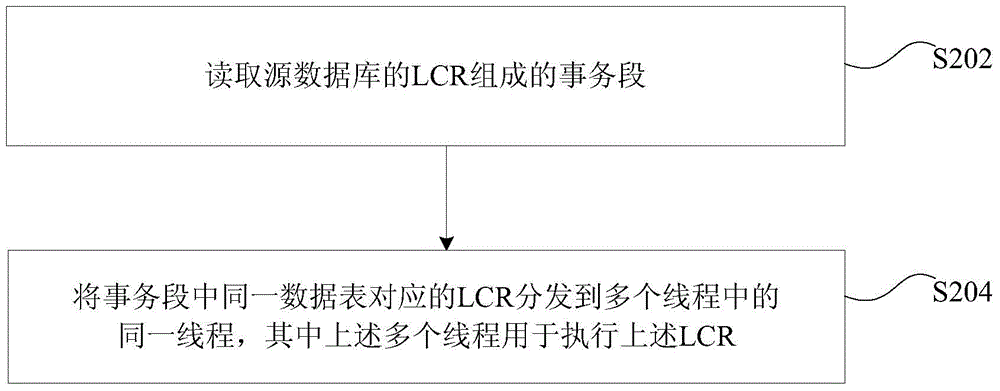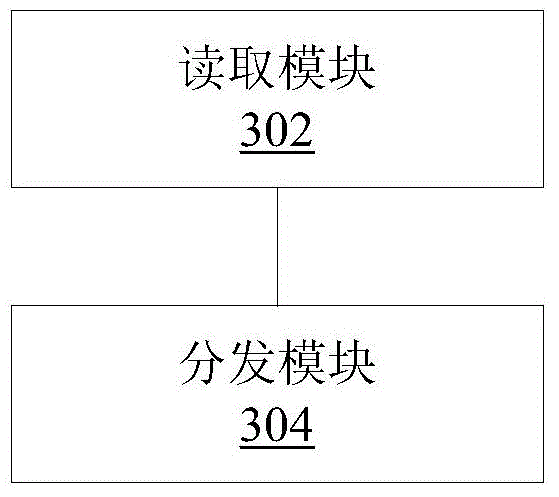Data synchronization method and apparatus for database system, and server
A data synchronization and database technology, applied in the field of communication, can solve the problems of low data synchronization efficiency in database systems, and achieve the effect of improving data synchronization efficiency
- Summary
- Abstract
- Description
- Claims
- Application Information
AI Technical Summary
Problems solved by technology
Method used
Image
Examples
example 1
[0089]This example illustrates that in a typical application scenario, there are two LCR operations on the same data table in one transaction:
[0090] Step A1: Assume that the data table TAB exists in both the source database and the destination database, defined as follows:
[0091] CREATE TABLE TAB(
[0092] FLD_A INT PRIMARY KEY,
[0093] FLD_B CHAR(10),
[0094] FLD_C VARCHAR(10)).
[0095] The three fields of the table represent the three most commonly used data types, among which FLD_A is the primary key.
[0096] Step B1: Execute a transaction on the table TAB in the source database, including one INSERT action and one UPDATE action:
[0097] BEGIN
[0098] INSERT INTO TAB VALUES(1,'A','B');
[0099] UPDATE TAB SET FLD_B='B',FLD_C='A'WHERE FLD_A=1;
[0100] COMMIT
[0101] Step C1: Capture these two actions through a certain LCR capture mechanism, and the content of the captured LCR is:
[0102] BEGIN: transaction start marker
[0103] LCR1 content:
[0104]...
example 2
[0124] This example illustrates that in a typical application scenario, there are two LCR operations on different data tables in one transaction, and the data synchronization is successful:
[0125] Step A2: The TAB structure of the table follows the table in Step A1 in Example 1. The table TAB1 is different from the table TAB only in the table name and has the same structure.
[0126] Step B2: Executing a transaction in the source database includes one INSERT action on the data table TAB and one INSERT action on the data table TAB1:
[0127] BEGIN
[0128] INSERT INTO TAB VALUES(1,'A','B');
[0129] INSERT INTO TAB1VALUES(2,'A','B');
[0130] COMMIT
[0131] Step C2: Through a certain LCR capture mechanism, capture the two actions of the transaction, and the content of the captured LCR is:
[0132] BEGIN: transaction start marker
[0133] LCR1 content:
[0134] Table name: TAB Operation type: INSERT
[0135] Field original value list: None (INSERT action has no origin...
example 3
[0154] This example illustrates that in a typical application scenario, there are two LCR operations on different tables in one transaction, data synchronization fails, and the transaction rolls back:
[0155] Step A3: The structure of the data table follows the table TAB and table TAB1 in the second example.
[0156] Step B3: Executing a transaction in the source database includes one INSERT action on the data table TAB and one INSERT action on the data table TAB1:
[0157] BEGIN
[0158] INSERT INTO TAB VALUES(1,'A','B');
[0159] INSERT INTO TAB1VALUES(2,'A','B');
[0160] COMMIT
[0161] Step C3: Use some kind of LCR capture mechanism to capture the two actions of the transaction, and the content of the captured LCR is:
[0162] BEGIN: transaction start marker
[0163] LCR1 content:
[0164] Table name: TAB Operation type: INSERT
[0165] Field original value list: None (INSERT action has no original value list)
[0166] List of new values for the field:
[0167...
PUM
 Login to View More
Login to View More Abstract
Description
Claims
Application Information
 Login to View More
Login to View More - R&D
- Intellectual Property
- Life Sciences
- Materials
- Tech Scout
- Unparalleled Data Quality
- Higher Quality Content
- 60% Fewer Hallucinations
Browse by: Latest US Patents, China's latest patents, Technical Efficacy Thesaurus, Application Domain, Technology Topic, Popular Technical Reports.
© 2025 PatSnap. All rights reserved.Legal|Privacy policy|Modern Slavery Act Transparency Statement|Sitemap|About US| Contact US: help@patsnap.com



